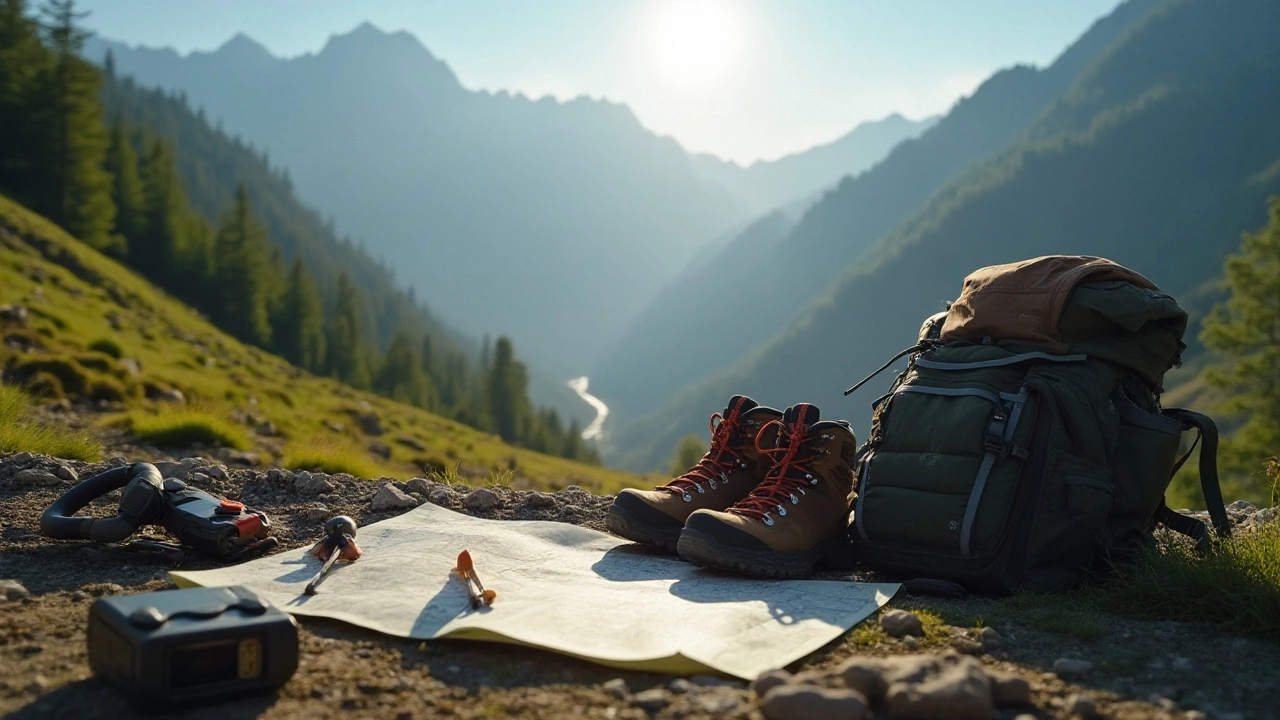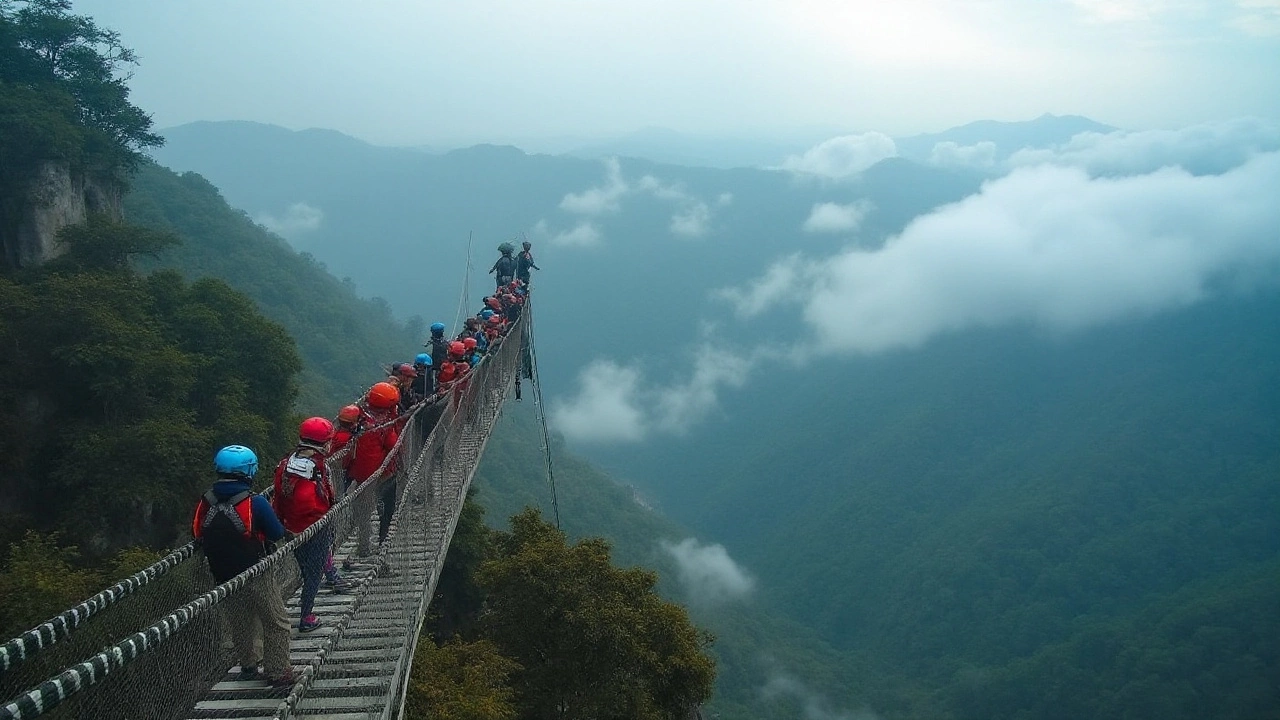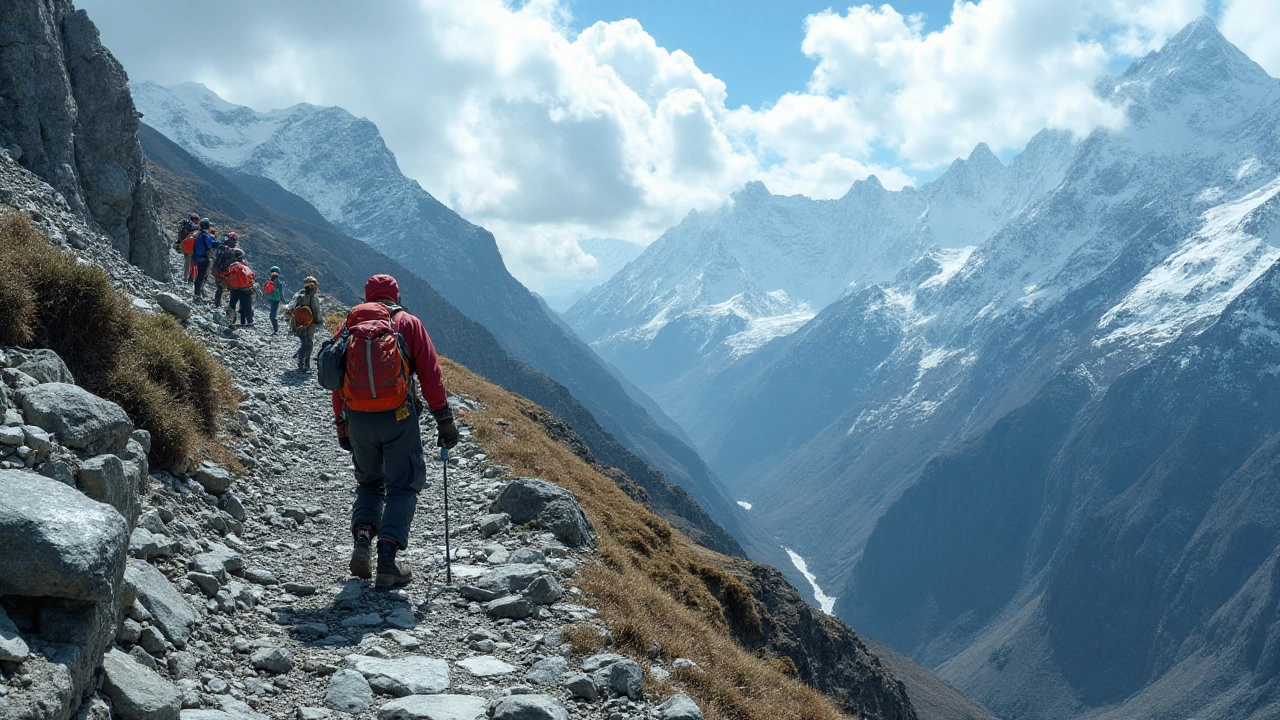India is a land of stunning contrasts, a place where every mountain range tells a story of its own. Among these towering giants, certain treks pose formidable challenges even for the most seasoned adventurers. These treks test not just physical endurance but also mental resilience, offering breathtaking views and profound experiences as their payoff.
The diversity of routes in India means there's something for every hiker, yet some trails push boundaries with their demanding paths. Today, we explore the most challenging trek that stands out in this vast and varied landscape. It's a journey that combines beauty with difficulty and promises to leave a mark on those daring enough to face it.
- Identifying the Most Difficult Trek
- The Trek's Unique Challenges
- Essential Preparation and Gear
- Safety Guidelines for Trekkers
- Experiences and Rewards
Identifying the Most Difficult Trek
When it comes to pinpointing the most demanding trek in India, it's not just about the altitude or harsh weather that climbers face. It's a mix of unpredictable terrains, the raw power of untouched nature, and the overall endurance required to reach these mystic destinations. The Kang La Trek in the remote regions of the Zanskar Valley is renowned for its daunting challenges. Nestled in the north of the dazzling Indian Himalayas, this trek stretches towards a formidable pass, offering trekkers both peril and incredible beauty.
Stretching over 11 days and covering more than 90 kilometers, the Kang La Trek begins in the quaint village of Durbe. Those embarking on this awe-inspiring journey have to navigate across icy river crossings, sharp ridges, and desolate landscapes. Experienced trekkers often highlight the solitude of these harsh terrains, where encountering another human soul is rare, adding an eerie yet thrilling sense of isolation. Experts suggest that the Kang La Trek should only be attempted by seasoned adventurers, as its steep ascents and dramatic temperature fluctuations make it a severe test of one's abilities.
Notably, the weather conditions are a challenge in themselves. The trek is typically tackled in the summer months, from June to September, when the snow has retreated enough to expose the trails. However, temperatures can still plummet, and rainfall often turns paths into slippery slopes. In fact, preparation is key, as this trek demands a meticulous eye for detail right from physical training to gear selection. One has to be in peak condition to face the steep elevation gains that come with every day's journey.
"It was as if the mountain had a voice, urging you to both conquer it and respect its untamed beauty," shared Rishi Desai, an accomplished trekker who has conquered some of the world's toughest trails.
A trekkers' survival guide would advise packing only essentials but ensuring every gear is lightweight and durable. From zapatos to trek poles, every item needs to withstand the rugged environment. Equally important is acclimatization to the high altitudes that reach up to 5,200 meters. Altitude sickness is a real threat here, which means listening to one's body becomes crucial. With each challenging incline, this adventure trek in India seems not just a physical journey, but also a path of self-discovery.
The Trek's Unique Challenges
Embarking on India's most difficult trek is not for the faint of heart; it demands not just physical strength, but also a spirit of adventure and resilience. This trek is a testament to the country's diverse terrain, with pathways winding through glacial corridors, temperamental weather systems, and altitudes that could make even seasoned climbers pause. One of the primary challenges is the altitude itself, often exceeding 5000 meters, where the air thins considerably, making oxygen scarce and every step more taxing than the last.
Another aspect that amplifies the difficulty is the unpredictable weather. What begins as a clear and sunny day can quickly deteriorate into harsh winds and snowstorms. Such conditions require trekkers to be perpetually on alert, adapting swiftly to changing environments. Moreover, the geographical isolation means that emergency assistance is not readily available; those on the trek must be self-sufficient, prepared with skills and resources to tackle any unforeseen complications.
The terrain itself is laden with challenges, from treacherous river crossings to steep ascents that might require the climber to use ropes and harnesses. It's a test of multitasking, where one's physical prowess must be matched by mental agility. Navigating rocky landscapes alongside sheer drops calls for meticulous planning and execution. These factors combined make it crucial for trekkers to continually adapt their strategy, always staying a step ahead of nature's surprises.
For many, the journey is not just a trek through India's wilderness but a deep dive into the rich tapestry of local cultures that thrive in these remote regions. Interacting with indigenous communities offers insight into their resilience at high altitudes, drawing patterns and lessons that trekkers can learn from. Exploring these cultural aspects becomes an integral part of the experience, presenting a unique blend of challenge and hospitality.
"Mountain treks are not for softies," said Anup Sah, a renowned mountaineer. "They transform you, almost like the mountains mold you into a new person."Those daring to take on this journey often find themselves facing their inner limits, pushing through with sheer willpower as the stunning panorama unfolds around them, providing the most gratifying reward amidst the ruggedness.

Essential Preparation and Gear
Embarking on the most difficult trek in India is not just a casual afternoon hike. It demands thorough preparation and the right gear to conquer its challenges. The first step to preparing is understanding the trek's specifics, such as the weather conditions, elevation, and length. For instance, this trek spans over several days and involves high-altitude passes where temperatures can plummet unexpectedly. So, it's crucial to acclimate your body to the thin air, which means training for at least a month in advance, focusing on enhancing stamina and muscle strength. Cardiovascular exercises like running or cycling can build fitness levels required to tackle steep inclines.
An essential part of preparation is mental readiness. This tough journey can be draining, and staying motivated is key. Joining trekking groups or reading about others' experiences can provide insight and motivation. A famous trekker once said, "The mountain teaches you to be humble in the face of its grandeur and patient in your journey." Such wisdom emphasizes the importance of mental preparedness for every trekker.
When it comes to gear, every piece of equipment counts. At the top of the list is sturdy footwear. Opt for high-ankle trekking boots with a good grip to prevent slips on rocky paths or snowy trails. A thermal jacket is indispensable due to unpredictable cold snaps, especially during night camps. Layering is critical, as it allows trekkers to adjust to weather fluctuations; think moisture-wicking base layers followed by insulating ones. A trekking in India essential is a good backpack – around 40-60 liters should suffice, balancing capacity with comfort. Ensure it has a rain cover to protect contents from sudden downpours.
Don't overlook navigation tools; a GPS device or physical maps are crucial as cell reception can be spotty in remote regions. Hydration packs are vital – higher altitudes increase dehydration risks, making it important to sip water frequently. Trekking poles help maintain balance and reduce stress on joints during long descents. Remember, what you carry should support self-sufficiency; pack high-energy snacks like nuts and dried fruits for quick boosts.
Adjustments might be necessary to deal with altitude sickness, a common foe on such challenging treks. Acetazolamide can prevent symptoms if taken a day before ascent, but consultation with a physician beforehand is wise. Keeping an eye on weather forecasts can save unnecessary risks; it's wise to pause if a storm brews. Personal safety should always trump schedules, and a flexible itinerary can accommodate these considerations. These preparations ensure a safe, successful trekking adventure.
Safety Guidelines for Trekkers
Embarking on the most challenging trek in India requires more than just a spirit of adventure. Safety is paramount, and there are several guidelines trekkers must consider to ensure their journey is both exhilarating and secure. First and foremost, understanding the terrain is crucial. Familiarize yourself with the topography and weather patterns of the region to anticipate potential obstacles. Whether it's slick mountain paths or unpredictable weather changes, being informed can significantly reduce risks along your trek.
Proper acclimatization is another critical factor when tackling difficult treks in India. Many of these treks involve high altitudes, where the thin air can pose risks of altitude sickness. It's important to ascend gradually and allow your body time to adjust to the changing oxygen levels. A rule of thumb often recommended by experienced trekkers is to climb high during the day but sleep at a lower altitude. This strategy helps mitigate the risks associated with altitude-related issues.
Equipping yourself with the right gear is essential. Trekkers should invest in high-quality boots designed for rough and rocky terrains. Layered clothing is advisable, as temperatures can fluctuate widely from scorching sunlit trails to chilly, windy mountain passes. Additionally, carrying a reliable map, a GPS device, or a compass ensures you remain oriented amidst the vast wilderness. Always pack sufficient food and water supplies, as staying hydrated and energized is key during these physically demanding adventures.
It's also imperative to have a well-stocked first aid kit. From blisters to altitude sickness pills, your kit should cover a range of emergency supplies. Trekkers should also be educated in basic first aid techniques to handle minor injuries when professional help isn't immediately accessible. In some cases, joining a trekking group or hiring a local guide can enhance safety. Guides offer valuable knowledge about the trail and local conditions, often foreseeing potential hazards no map or guidebook can highlight.
Trekking in India is a delightful challenge, yet safety precautions cannot be undermined. A quote from a seasoned mountaineer, Reinhold Messner, captures this perfectly:
"Mountains aren’t fair or unfair, they’re just dangerous."This wisdom underscores the importance of preparation and respect for nature's unpredictability. Trekking should be a joy, unmarred by accidents and mishaps, and by following these safety guidelines, adventurers can focus on the thrill of discovering India’s awe-inspiring landscapes.

Experiences and Rewards
Embarking on India's most difficult trek is more than just a test of physical strength; it is a journey into the very soul of the country’s majestic landscapes. Trekkers find themselves plunged into the wild beauty of untouched nature, where the air is crisp, and the skies are a canvas of changing hues. With each step, adventurers gain a newfound appreciation for the resilience and diversity woven into India’s natural tapestry. The experience is punctuated by serene moments of solitude and breathtaking vistas that challenge the very notion of beauty.
Many who take on such a trek report a sense of profound introspection. As you navigate challenging terrains, you're afforded the time and space to reflect on the hustle and bustle of life below. Nature has a way of teaching patience, as trails wind slowly up rugged paths where every step is earned. Along this trek, you'll encounter a striking diversity of wildlife and flora that blankets the region, each with its evolutionary stories. The trek is arduous, but each challenging climb brings you closer to panoramic views that seem to stop time.
These arduous paths provide an unparalleled connection with nature, but they also foster bonds among fellow trekkers. Sharing this formidable journey often forges friendships that last a lifetime. As the climb demands cooperation and spirit, enduring camaraderie is born. Nights spent around campfires under starlit skies become treasured memories, made sweeter with the shared hardships of the day’s trek. Every fatigue-fueled meal is not just sustenance but a celebration of the day's success.
The rewards of completing such a challenging trek go beyond the physical. There is an intrinsic satisfaction in reaching the summit of a particularly daunting climb. Your efforts are paid back tenfold with views that literally take your breath away. It’s said by many trekkers: “The mountain you conquer is not the one beneath your feet but the one within.” These experiences instill a belief in your capabilities, instigating a spirit that can take on life's personal peaks.
Chris Bonington, a legendary mountaineer once aptly expressed, "Mountains aren't fair or unfair - they're just dangerous."These words resonate with those who dare to tread such paths.
Finally, no article about difficult treks in India would be complete without highlighting the cultural experiences en route. Often, these treks pass through remote villages, offering glimpses into the traditional lifestyles of the inhabitants. Engaging with the local people adds a rich layer of cultural understanding, deepening the trek's overall impact. Trekkers are often welcomed with warm hospitality and can witness firsthand the harmony between the communities and their formidable environment. It’s a transformative experience that leaves you richer, not in possessions, but in knowledge and empathy.
